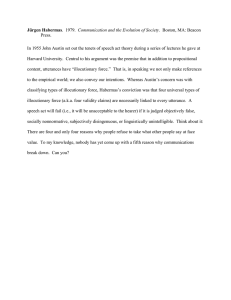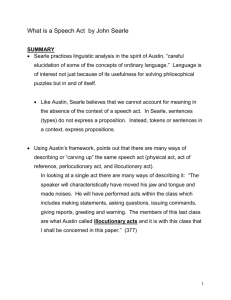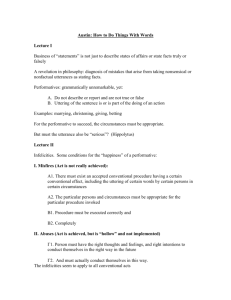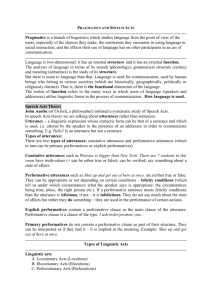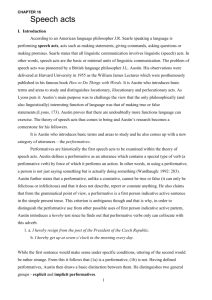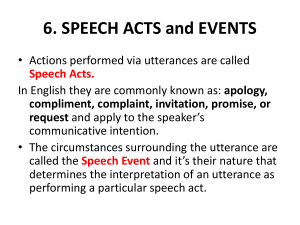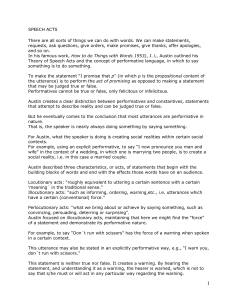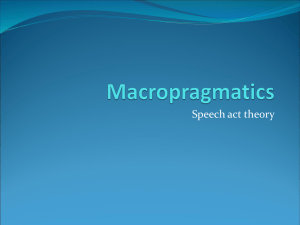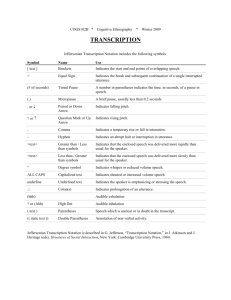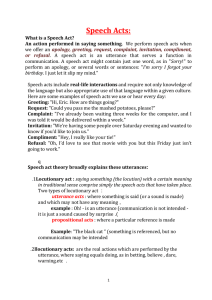Lecture Note #...: SPEECH ACT
advertisement
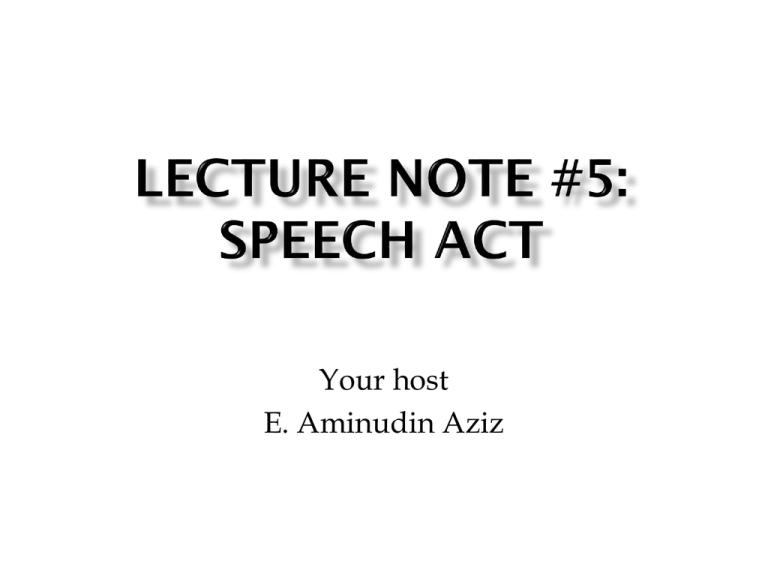
Your host E. Aminudin Aziz Austin’s observation on (many or even most) acts realised through speech People do things with words The idea sharply contrasts with truth conditions semantics which relies on logical relations of sentences and the truthfulness (or availability) of references in the real (as well as imaginary) world Austin’s claim about Ordinary Language Philosophers In his early work on speech acts, the philosopher Austin drew a distinction between constative utterances, like The cat sat on the mat, which had a purely descriptive (statementmaking) function and which could be treated in terms of truth and falsehood, and performative utterences, like I promise it will never happen again, which he claimed were neither true nor false but felicitous or infelicitous. A performative verb is one which designates a specific speech act and which, if used appropriately, counts as the performance of the speech act. In his later work, Austin dropped this distinction in favour of a distinction between explicit performatives (like I promise it will never happen again) and primary or implicit performatives (like It will never happen again, functioning as promise). A performative verb in a performative use can typically be accompanied by hereby (cf. IFIDs) a) b) c) “the conditions that must be satisfied for a speech act to be properly performed” (aka “happiness conditions”) preparatory condition [P]: it defines an appropriate setting for the act, including the speaker’s intentions and qualifications; sincerity condition [S]: it requires the speaker to be sincere; essential condition or illocutionary intention [I]: it defines the essential nature of the speech act. E.g.: a promise can be defined as [P] S genuinely believes that S can do A [S] S willingly intends to do A of his own volition [I] S reflexively-intends that U be a reason to believe that S willingly undertakes the obligation to do A and intends to do A. a refusal can be defined as an utterance in which [P] S is unable and/or unwilling to do A [I] S intends that U be a reason for H to believe that S is unable or unwilling to do A [I] S reflexively-intends that H take U to be a reason to believe that S is unable or unwilling to do A A locution has to do with the actual utterances produced by a speaker. It can be in the forms of declarative, imperative, or interrogative sentences. E.g. a) I order you to leave immediately b) Go away! c) Out! d) Won’t you stay here? : declarative : imperative : declarative : neg. interrogative An illocution is the force or intention behind words. The illocution is the property of the utterance. Notice the IFID order in the example a) above. The use of the performative verb order explicitly states the illocutionary point of the utterance, i.e. a command. The imperative in b) is a conventionalised way for Speaker S to tell Hearer H to do something, and one that leaves no room for doubt when spoken with appropriate prosody). To have the illocutionary force of a command, c) must be spoken with appropriate prosody and in an appropriate context (cf. the same utterance uttered by an umpire in a game of tennis) Illocutionary acts as the “central interest” of Austin’s speech act theory) A perlocution is the effect of the utterance on Hearer H. Suppose Speaker S says There is a spider on your lap. In saying this, S is making a statement about the location of a spider; i.e. the utterance has the illocution of a statement. It may also the case that by uttering the utterance, Speaker S frightens H alerts H by warning him/her persuades H to an opinion by stating supporting facts intimidates H by threatening him/her gets H to do something by means of a request or command. etc 1. Searle (1976): performative verbs as the basis Representatives: asserting, concluding ii. Directives: requesting, questioning iii. Commissives: promising, threatening, offering iv. Expressives: thanking, apologising, welcoming, congratulating v. Declarations: declaring war, christening, firing from employment i. 2. Allan (1986; 1994; 1998) i. Interpersonal Acts defined on the basis of two felicity conditions: a preparatory condition [P] which invokes the value, and a sincerity condition [S]. The third element in the definition is the illocutionary intention [I], which represents S’s reflexiveintention that H should recognise that in uttering U, S intends to have H recognise his/her particular illocution. The preparatory condition is presupposed by the sincerity condition. 1. 2. 3. 4. 5. 6. Constatives (truth values) Predictives (probable-truth values) Commissives (genuinness values) Acknowledgements (appropriacy values) Directives (compliance values) Authoritatives (authority values) ii. Declaratory Acts (authority values) is typically broadcast within a social group; and the act relies for its success on S being sanctioned by the group, or by a community, institution, committee, or even a single person within the group, to perform such acts under stipulated conditions, which are unnecessary for interpersonal acts, including: i. an executive condition of the speaker [Es] ii. an executive condition on the utterance [Eu] iii.an executive condition on the context in which U is uttered by S [Ec] Effectives (bring about states of affairs such as baptism, marriage, knighting, etc.) Verdictives (express decisions on states of affairs, often through S declaring a choice between competing possibilities)

